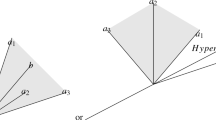Abstract
This paper addresses an upper bound derived by Kitahara and Mizuno (Math Program A 137:579–586, 2013) on the number of basic feasible solutions of a linear program generated with the simplex algorithm. Their bound includes two parameters \(\delta \) and \(\gamma \), which are respectively the minimum and the maximum values of positive components in all basic feasible solutions. We show that \(\delta \) is NP-hard to determine while \(\gamma \) can be computed in polynomial time. We also report some numerical results using alternative parameters for \(\delta \) and \(\gamma \).
Similar content being viewed by others
References
Adler, I., Papadimitriou, C., Rubinstein, A.: On simplex pivoting rules and complexity theory. In: Proceedings of the 17th International Conference on Integer Programming and Combinatorial Optimization, pp. 13–24 (2014)
Chvátal, V.: Linear Programming. WH Freeman, New York (1983)
COIN-OR: Linear Programming Solver. https://projects.coin-or.org/Clp (2012)
Dantzig, G.B.: Linear Programming and Extensions. Princeton University Press, Princeton (1963)
Fearnley, J., Savani, R.: The complexity of the simplex method. In: Proceedings of the Forty-Seventh Annual ACM Symposium on Theory of Computing (STOC’15), pp. 201–208 (2015)
Garey, M.R., Johnson, D.V.: Computers and Intractability: A Guide to the Theory of NP-Completeness. WH Freeman, New York (1979)
Karmarkar, N.: A new polynomial algorithm for linear programming. Combinatorica 4, 373–395 (1984)
Karp, R.M.: Reducibility among combinatorial problems. In: Miller, R.E., Thatcher, J.W. (eds.) Complexity of Computations, pp. 85–103. Plenum Press, New York (1972)
Khachiyan, L.G.: Polynomial algorithms in linear programming. USSR Comput. Math. Math. Phys. 20, 53–72 (1980)
Kitahara, T., Mizuno, S.: A bound for the number of different basic solutions generated by the simplex method. Math. Program. A 137, 579–586 (2013)
Kitahara, T., Mizuno, S., Matsui, T.: On the number of solutions generated by Dantzig’s simplex method for LP with bounded variables. Pac. J. Optim. 8, 447–455 (2012)
Littman, M.L., Dean, T.L., Kaelbling, L.P.: On the complexity of solving Markov decision problems. In: Proceedings of the eleventh Annual Conference on Uncertainty in Artificial Intelligence (UAI’95), pp. 394–402 (1995)
McMullen, P.: The maximum numbers of faces of a convex polytope. Mathematika 17, 179–184 (1970)
Netlib: Netlib Collection of LP Problems in MPS Format. http://www.netlib.org/lp/data (1988)
Terlaky, T., Zhang, S.: Pivot rules for linear programming: a survey on recent theoretical developments. Ann. Oper. Res. 46, 203–233 (1993)
Ye, Y.: The simplex and policy-iteration methods are strongly polynomial for the Markov decision problem with a fixed discount rate. Math. Oper. Res. 36, 593–603 (2011)
Author information
Authors and Affiliations
Corresponding author
Additional information
Takahito Kuno: Partially supported by a Grant-in-Aid for Scientific Research (C) 16K00028 from the Japan Society for the Promotion of Sciences. Yoshio Sano: Partially supported by a Grant-in-Aid for Young Scientists (B) 15K20885 from the Japan Society for the Promotion of Sciences.
Rights and permissions
About this article
Cite this article
Kuno, T., Sano, Y. & Tsuruda, T. Computing Kitahara–Mizuno’s bound on the number of basic feasible solutions generated with the simplex algorithm. Optim Lett 12, 933–943 (2018). https://doi.org/10.1007/s11590-018-1276-4
Received:
Accepted:
Published:
Issue Date:
DOI: https://doi.org/10.1007/s11590-018-1276-4




